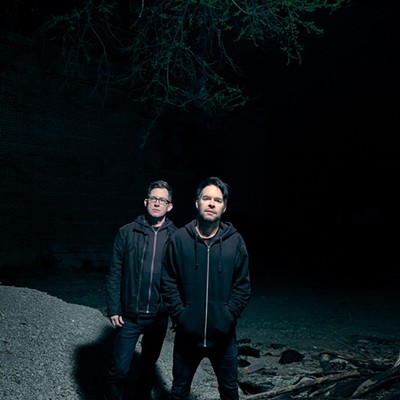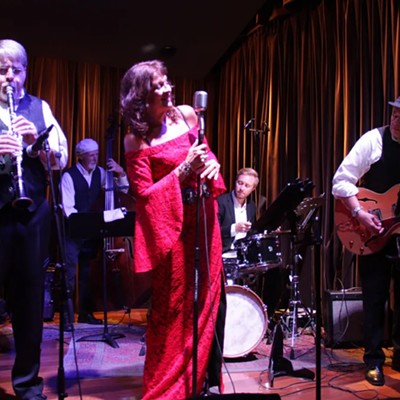John Averill, bass player and leader of the MarchFourth Marching Band, says the group's joyous, freewheeling and funky performances are designed with both adults and children in mind.
I'll go a step further: When I saw MarchFourth, it made this adult feel like a kid again.
Named for the date on which it formed, MarchFourth is a collective from Portland, Ore., that usually performs with almost two dozen members: horn players, a drum corps, dancers, fire breathers, clowns and stilt-walkers. The group plays a few covers, but its material is primarily original, drawing inspiration from jazz and big-band music, rock, funk, vaudeville, conventional marching bands, gypsy and Balkan music, a wide range of Latin, Caribbean and African styles, TV and film scores and the New Orleans second-line tradition.
Averill was one of the five founding members who agreed to learn seven cover tunes for a Mardi Gras party on March 4, 2003. The band exploded from there, he says.
"In the beginning, we never really planned out where we wanted to go. This thing has taken off with a life of its own. Leading this project is a lesson in learning how to not over-control the situation. It's like a chariot with 18 horses, and it took off right out of the gate. The individual players and their influences dictate where we go with it."
MarchFourth will return to Tucson to play this Friday, June 4, at Hotel Congress, as part of the event March Into Summer, presented by the Parasol Project. The festivities will also include an appearance by the local "pirate string band" The Missing Parts and a circus cabaret featuring jugglers, freaks, aerial performers, clowns and dancers.
Tucsonans were first introduced to MarchFourth one balmy Friday night last October. The band played an early-evening set at the annual cultural festival Tucson Meet Yourself in El Presidio Park. As that performance wound down, MarchFourth marched through the Pima County Courthouse arch, took a quick jog on Church Avenue to Congress Street, then headed east, playing the entire time—with a growing crowd joyfully following behind.
At a few street corners, MarchFourth took a break from marching to play on the sidewalk, blasting funky brass and drums through the Tucson night. At a couple of stops, local horn players spontaneously jumped in to jam with the group.
When the band arrived at the Hotel Congress, it took a quick break to set up on the outdoor stage and played another complete set under the stars, while the dancers and stilt-walkers mixed, mingled and danced with the audience.
MarchFourth can't stage impromptu parades in every city. The members have to research local ordinances and regulations beforehand, Averill says.
"In some places, you can get fined for performing on a city street without a license. In some places, they'll fine you $500. Per person."
Indeed, every MarchFourth performance is different.
"To a certain extent, we always want to keep that spontaneity as a very important ingredient to the whole thing. A lot of our material is arranged in ways to allow for that. A lot of the songs have open-ended arrangements, and it depends on who's soloing or the rest of the chemistry that dictates how a show will be. Sometimes that means random performers come up to us on the street to play as well."
Averill says some of the current MarchFourth players actually were drawn into the group after joining in during street performances. Nowadays, the extended roster for MarchFourth includes about 35 musicians and performers, although only about 20 travel together for each tour, he says.
"Some of them have other commitments. Some are on the first-call list; some are considered substitutes. The money can only spread so far. We're not making really great money, but I'd rather pay decent money to 20 people for a tour than take 30-plus and have them not making hardly anything."
Averill, 42, says an average MarchFourth tour will include a maximum of five or six horn players, eight drummers and four to six dancers and/or stilt-walkers. And, of course, there's Averill on bass, trailing a cart with a battery-powered amplifier.
The members come from a variety of musical backgrounds, Averill says.
"The horns have more of the formal training, and some of the drummers have experience in school band or marching band. I didn't personally have marching band in my background. I'm more of a rock guy, originally. But now, I can write music for a mini-orchestra, and have nine different drum parts if I want.
"And I don't take it for granted, either. I feel really grateful that the band is still together and gets along as well as it does. I mean, we've had our growing pains and challenging moments, but compared to what I hear about other 'alternative marching bands' out there, we are a pretty well-adjusted group."
MarchFourth has recorded and released three independent albums, the most recent being Rise Up. To the group's credit, the music is excellent on disc, too.
"That's nice to hear, because that aspect is important to me. We don't just want it to be about the spectacle. We want it to sound like a real band that makes real music that moves you and records CDs that preserve that experience," Averill says.
Most of the band's members also are full- or part-time artists, designers and craftspeople, who design and fabricate every piece of hardware used, from the stilts to the drum harnesses. And each individual member creates his or her unique uniform.
"Everybody can do whatever they want in terms of how they look, for better or worse. Some of us can use a little more fashion sense. Some of the members look really good, and some people roll out of bed, put on a hat and call it good."







